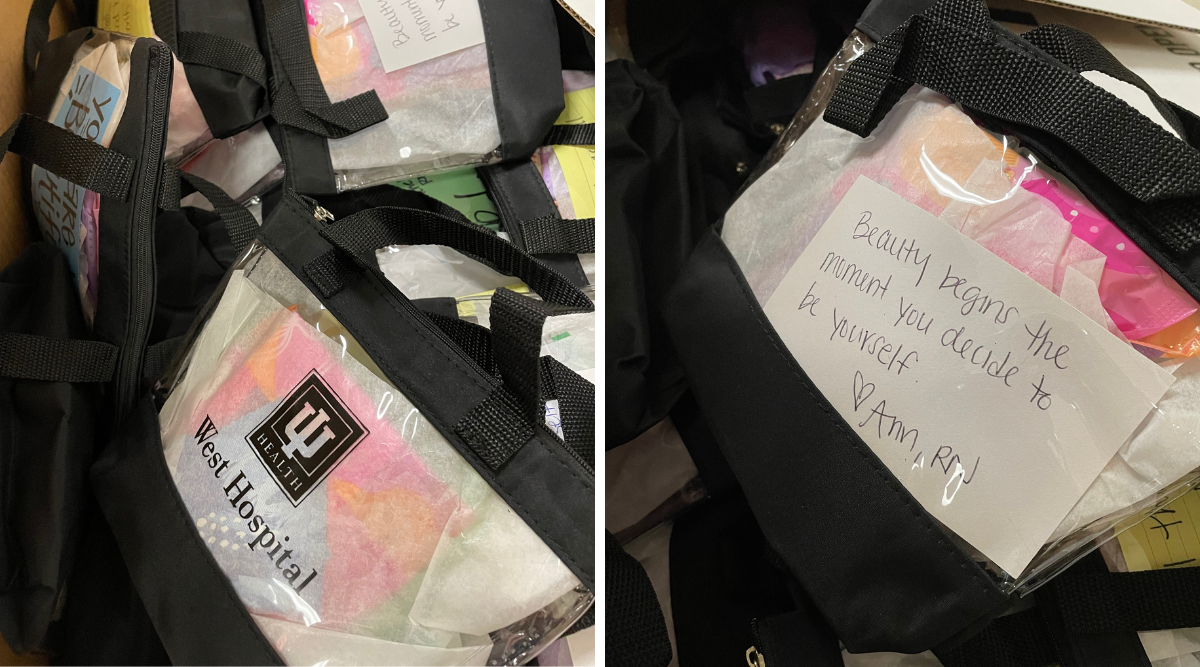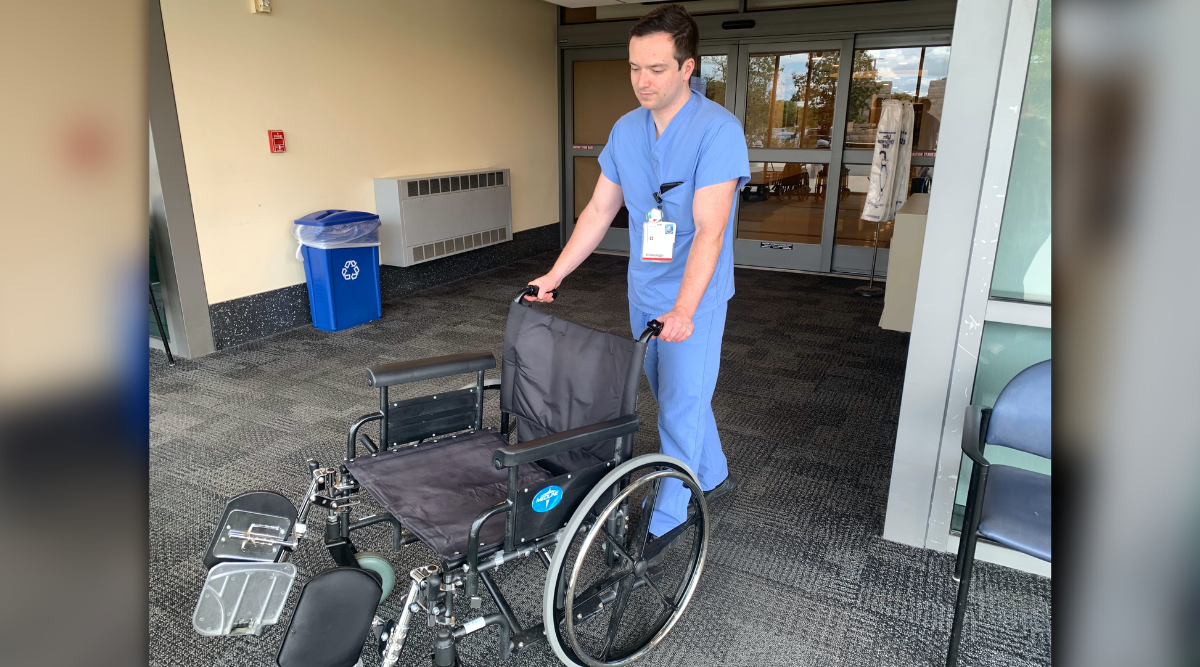Paula Pendleton is a nurse who facilitates transferring patients from outside hospitals to the right location and level of care within the IU Health system. “It can get hectic at times and be kind of a timing game, but at the end of the day, I take pride in knowing that I have helped this patient get to the best place they need to be.”
Month: September 2023
Team supervisor reflects on career growth that spans more than two decades
Debora Farrell started at IU Health in 2001 working in the film room at Riley Hospital for Children. Since then she has held several positions that have prepared her for her current role as scheduling team supervisor. “I started August 13, 2001, which was my birthday. When I post [on social media] that it’s my birthday I always add that it’s my work anniversary and that really makes me proud. It’s like, you’ve earned the right to be proud of this.”
Dad’s new heart beats strong for daughter’s wedding
Let’s talk: Period.
By Emma Avila, epackard1@iuhealth.org, writer for IU Health’s Indianapolis Suburban Region
Team members at IU Health West are taking steps to help local young women before and after they have their first menstrual cycle.
Menstruation is a normal and healthy part of life for most women, but as common as it is, it can be difficult to talk about. Periods begin during puberty, which means many young girls are navigating their first and proceeding menstrual cycles during school hours. IU Health West nurses and an OB/GYN want to make sure girls have the supplies and information they need.
In partnership with the Wayne Township Education Foundation and Stout Elementary School, IU Health West nurses recently held a hygiene kit drive to assemble packs the school nurse will use throughout the year for girls who need help with their period. The kits include a pad, wipes, new underwear, a few other items and a note of encouragement from a nurse.

The team was able to assemble 100 kits, which should last the entire school year.
Conversations surrounding periods can be difficult, both at school and at home. Dr. Jessica Healey, OB/GYN at IU Health West and mom of two young daughters, knows it’s important for young girls to be prepared and informed. Below, she answers some questions about the menstrual cycle, how to approach conversations surrounding the topic, and how an OB/GYN can help.

What is the menstrual cycle?
“When a girl reaches puberty, the brain will start to produce hormones that signal changes in the body, which are meant to prepare her body to be able to become pregnant. Those hormones will thicken an inner layer of tissue inside the uterus called the endometrium so that it can provide blood flow to a potential pregnancy. A menstrual period occurs when the body then recognizes that it’s not pregnant and will shed this endometrial lining. Women will often experience cramping as the muscle of the uterus contracts to help push out this old blood and tissue. This is experienced by women as the blood and tissue leave the uterus through its opening called the cervix. It then comes out through the vagina and is seen as blood, or better known as a period.
All of this is regulated by hormones from the brain and the ovaries, which can change daily in a woman’s natural cycle. Period bleeding usually lasts anywhere from three to seven days. A normal cycle will occur every 24 to 32 days.”
Why is this healthy for the female body?
“It’s healthy for the body because it allows the uterus to grow a new fresh lining for a potential pregnancy each month, making sure that the tissue that is there is healthy and has everything it needs for a potential pregnancy. The layer of tissue then must leave the body each month because the hormones stimulate growth of new tissue each cycle. If there’s overgrowth of the tissue inside the uterus, meaning it doesn’t leave because menstruation or a period isn’t occurring, this can lead to heavy or irregular bleeding, pelvic pain or other long-term issues.”
When do girls typically get their first period?
“Average age of starting the first period is 12 or 13. Some girls can start as young as age eight and others may not start until as late as age 15. If they haven’t started by about age 15, they probably should start having conversations with their doctor.
I have two daughters; they are eight and five. Some of my experience is based off of my job and some is based off of being a mom. In my opinion, having multiple smaller conversations over the couple of years before your daughter is due to start her period can help make her more comfortable talking about it over time. As an OB/GYN, I was nervous about these conversations with my own two daughters, but I have found that they are extremely curious. I’m just very open with talking with them about things like breast growth, menstrual bleeding, how babies develop and how they are born.”
Do you have any tips on how to approach these conversations?
“I think listening to the curiosity your child has and being willing and open to discuss those things when they come to you is important. Being able to just educate yourself on the menstrual cycle and what your child might experience is also key. A lot of adults still don’t really understand what it is or why it’s happening or the timeline of how things happen. If that’s the case, do your own research or, if you have an OB/GYN, you can ask them those questions. If you feel very uncomfortable, it’s also very reasonable and appropriate to ask either your child’s pediatrician or have your child see an OB/GYN to have these initial discussions.”
Kidney transplant had ‘domino effect’ on this author
Nurse spotlight: Kelly Wilson
Kelly Wilson was a welder before turning his focus toward helping people. He worked as a patient care assistant in the emergency department at IU Health Arnett and then took the necessary steps to become a nurse. “I think I made the right choice… we’re here for one common goal and that’s to make someone’s worst day better.”
Team spotlight: Chellsee Pruitt
Chellsee Pruitt is a registered respiratory therapist who cares for patients who are on a heart lung bypass machine known as ECMO. “We are taking blood out of a person’s body and running through a pump, through an oxygenator, which is where the gas exchange happens, and then we return the blood to the patient… it’s probably the ultimate form of life-support, besides being on a pump in OR.”
Learning on the job: Meet Austin Dale
Written by Emma Avila, epackard1@iuhealth.org, writer for IU Health’s Indianapolis Suburban Region
Because of his time working at IU Health North, Austin Dale is now pursuing a long-term career in healthcare.
Austin Dale began working at IU Health North in January 2020. He started on the patient transportation team, helping patients move from one area to another.
“Typically, when a patient needs to go to a test, imaging scan or they need to transfer from one room to another, nurses don’t always have time to move the patients themselves. We also help with discharges,” he explained. “I was looking for something that would bring me into an entry level position while providing some areas where I could expand.”

After working in a hospital environment, Dale decided to pursue a career in healthcare. He began taking nursing classes, but eventually decided to go into radiography. He is currently taking classes at Indiana University-Purdue University Indianapolis.
“I realized after working with a lot of patients that I enjoyed making a difference,” he said. “The need for radiology techs is really big right now.”
Now, Dale is a student intern for the IU Health North imaging department a few days a week while still working in patient transportation a few days as well.
“The [patient transport] team encouraged me to pursue radiography for some time,” he said. “I already knew everyone there so that was really helpful too.”
He feels thankful for the opportunities and connections the hospital has provided.
“I’m really grateful to so much of the staff. They are a really good team overall.”
Male hoopster’s cancer discovered through pregnancy test
Four Conditions You Didn’t Know Could Be Treated With a Virtual Visit
Virtual visits and telehealth options have emerged in recent years as a convenient and effective way to seek care for a wide range of conditions.
While you may be familiar with using virtual care options for issues like colds and rashes, you might be surprised to learn there are several other conditions that can be treated with a virtual visit. Let’s investigate a few of them.
1. Viral and Bacterial Infections
In the past, facing a viral or bacterial infection might have prompted a trip to a physical urgent care clinic or your primary care provider. With the advancement of telemedicine, many common infections can now be evaluated and treated with a virtual visit.
Whether it’s a sinus infection, strep throat, or even a suspected case of COVID-19, providers can assess your symptoms, guide you on self-care, prescribe medications if needed, and recommend when an in-person examination becomes essential.
During your virtual visit, be prepared to provide detailed information about your symptoms and their onset. Depending on the specific infection, the provider might request and order additional labs or tests to correctly diagnose and treat your illness.
When it comes to antibiotics, it’s crucial to understand their proper usage and potential risks. Antibiotics do not work against viral infections, such as the common cold or flu. If antibiotics are taken when they aren’t needed, resistance to them can develop. Using antibiotics responsibly keeps their effectiveness when needed later.
2. Allergies
Seasonal allergies can be problematic, causing a runny nose, congestion, sneezing and itchy eyes. While they might not seem serious, they can significantly impact your quality of life. In many cases with allergies, they can be managed effectively with virtual visits. A provider can discuss your symptoms, recommend over-the-counter treatments, suggest environmental modifications, and advise when a prescription might be the right treatment plan.
Allergies often have characteristic symptoms that can be described and discussed without the need for a physical examination. Be prepared to discuss the duration and pattern of your symptoms, triggers that worsen them, and any previous treatments you’ve tried. Images of any visible symptoms, such as skin reactions, can also aid in diagnosis.
3. Urinary Tract Infections (UTIs)
Many cases of UTIs can be managed through a virtual visit. A provider can discuss your symptoms, review your medical history, and prescribe antibiotics if necessary.
UTIs often have classic symptoms like frequent urination, a burning sensation, and cloudy urine, which can be easily discussed in a virtual consult. If you experience severe pain, blood in your urine, fever, or if you are pregnant, an in-person evaluation may be recommended to rule out complications. You’ll likely be asked about your symptoms, any history of UTIs, and your general health. A urine sample might be requested to confirm the diagnosis before prescribing antibiotics.
4. Skin Issues
Skin problems like acne, rashes, or minor infections can often be evaluated in a virtual setting. A provider can assess the visual appearance of the issue, discuss your symptoms, and recommend topical treatments or other interventions.
Be prepared to provide a clear description of the skin issue, its location, and any associated symptoms. High-quality images or videos of the affected area will aid in diagnosis. If a skin problem is rapidly worsening, causing extreme pain, or if you suspect it might be related to an underlying health condition, an in-person evaluation might be more appropriate.
While virtual visits have their limits, they offer a practical and efficient solution for treating a surprisingly broad range of conditions without having to leave home. You can get in touch with a highly skilled provider when you need it most.
Remember that virtual visits are not a one-size-fits-all solution―in some cases additional labs or tests may be required to properly diagnose the condition and create the right treatment plan. For more complex or severe cases, in-person care remains crucial. Always consult with a provider to determine the most appropriate course of action for your specific situation.
IU Health On-Demand Virtual Visits are available 24/7 for anyone over the age of 2 in Indiana. Visit iuhealth.org/virtualvisits to learn more or to start a virtual visit.
